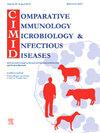埃塞俄比亚南部 Elwayye 地区骆驼布鲁氏菌病的血清流行率、相关风险因素和经济影响。
IF 2
3区 农林科学
Q4 IMMUNOLOGY
Comparative Immunology Microbiology and Infectious Diseases
Pub Date : 2024-10-13
DOI:10.1016/j.cimid.2024.102257
引用次数: 0
摘要
背景:骆驼布鲁氏菌病是一种人畜共患病,也是一种重要的经济疾病,会导致动物生产力低下,并因流产和畜群繁殖力低下而死亡:方法:2023 年 3 月至 12 月期间进行了一项横断面研究,以估计埃塞俄比亚南部 Elwayye 地区骆驼布鲁氏菌病的血清流行率、相关风险因素和经济影响。研究人员从广泛饲养和传统管理的单峰骆驼身上共采集了 240 份血样。采集的样本通过玫瑰红平板试验(RBPT)和间接酶联免疫吸附试验(ELISA)进行布鲁氏菌抗体检测:在本次研究中,通过 RBPT 检测骆驼布鲁氏菌病的总血清流行率为 6.2%,通过 RBPT 和 ELISA 联合检测的总血清流行率为 3.7%(95 % CI:1.94-7.05)。研究评估了牛群规模、年龄、管理方法、流产史和性别等风险因素。其中,年龄、畜群规模和管理方法被确定为与骆驼布鲁氏菌血清阳性显著相关的潜在风险因素。但其他风险因素与该疾病无关(P > 0.05)。在这项研究中,根据所使用的所有参数,估计研究地区骆驼布鲁氏菌病造成的经济损失总额为 505727.2 埃塞俄比亚比尔(ETB)。小骆驼流产或围产期死亡造成的经济损失最高(341,325 埃塞俄比亚比尔):这些都表明有必要对研究地区的骆驼布鲁氏菌病进行研究,该疾病在牧区是地方性流行病,需要组织完善的监测、疾病控制和预防计划。本文章由计算机程序翻译,如有差异,请以英文原文为准。
Sero-prevalence, associated risk factors and economic impact of camel brucellosis in Elwayye district, southern Ethiopia
Background
Camel brucellosis is a zoonotic and economically important disease that causes low productivity and mortality in animals through abortion and low herd fertility.
Methods
A cross-sectional study was conducted from March to December 2023 to estimate the seroprevalence of camel brucellosis, associated risk factors, and economic impact in Elwayye district, southern Ethiopia. A total of 240 blood samples were collected from extensively and traditionally managed dromedary camels. The collected samples were subjected to testing for Brucella antibodies using the Rose Bengal Plate Test (RBPT) and indirect ELISA for confirmation.
Results
The overall seroprevalence of camel brucellosis in the current study by RBPT was 6.2 %, and by combined RBPT and ELISA, it was 3.7 % (95 % CI: 1.94–7.05). Risk factors like herd size, age, management practice, history of abortion, and sex were assessed. Among these, age, herd size, and management practice were identified as potential risk factors significantly associated with Brucella seropositivity in camels. But the other risk factors were not associated with the disease (P > 0.05). In this study, the total estimated economic loss due to camel brucellosis in the study area was 505,727.2 Ethiopian birr (ETB) for all parameters used. The highest economic loss was due to abortion or perinatal mortality of calves (341,325 ETB).
Conclusions
These indicate the need to study camel brucellosis in the study area, and the disease is endemic and prevalent in pastoralist areas, which need well-organized surveillance, disease control, and prevention programs.
求助全文
通过发布文献求助,成功后即可免费获取论文全文。
去求助
来源期刊
CiteScore
4.60
自引率
0.00%
发文量
102
审稿时长
40 days
期刊介绍:
Comparative Immunology, Microbiology & Infectious Diseases aims to respond to the concept of "One Medicine" and to provide a venue for scientific exchange. Based on the concept of "Comparative Medicine" interdisciplinary cooperation between specialists in human and animal medicine is of mutual interest and benefit. Therefore, there is need to combine the respective interest of physicians, veterinarians and other health professionals for comparative studies relevant to either human or animal medicine .
The journal is open to subjects of common interest related to the immunology, immunopathology, microbiology, parasitology and epidemiology of human and animal infectious diseases, especially zoonotic infections, and animal models of human infectious diseases. The role of environmental factors in disease emergence is emphasized. CIMID is mainly focusing on applied veterinary and human medicine rather than on fundamental experimental research.

 求助内容:
求助内容: 应助结果提醒方式:
应助结果提醒方式:


